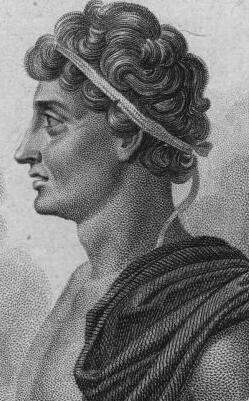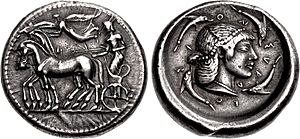Gelon facts for kids
Gelon, also called Gelo, was an important leader in ancient Sicily. He lived in the 400s BC. Gelon was the son of Deinomenes. He became the first ruler from the Deinomenid family. Gelon controlled the cities of Gela and Syracuse.
Contents
Gelon's Early Life and Family
Gelon was the son of a man named Deinomenes. His family came from an island called Telos in the Aegean Sea. Later, they helped start the city of Gela in southern Sicily.
Gelon had three brothers: Hieron, Thrasybulus, and Polyzalos. An ancient writer named Herodotus said that Gelon's family were priests. They followed a special cult of Earth Goddesses.
Gelon was a skilled soldier. He fought in many battles between the different rulers of Sicily. He became known as a very strong fighter. Because he was so good, he was made the commander of the cavalry. This was the horse-riding part of the army. He worked for his uncle, Hippocrates, who was the ruler of Gela. Gelon played a big part in many battles, even against Syracuse. He would later take over Syracuse himself.
How Gelon Became a Powerful Ruler
Gelon's journey to power began when Hippocrates was killed. This happened in a battle against the native Sicel tribe. After Hippocrates died, his sons tried to keep control. But the people of Gela were tired of their family ruling. They started a revolt.
Gelon stepped in, pretending to help Hippocrates' sons. Instead, he used the army to take power for himself in 491 BC. He now controlled Gela and other areas. These included Naxos in the east, Zancle in the northeast, and Camarina in the south.
Gelon Becomes Tyrant of Syracuse
Gelon ruled Gela peacefully for five years. In 485 BC, a group of nobles from Syracuse asked for his help. They were called the Gamori. The common people had forced them out of Syracuse.
Gelon saw this as a chance to expand his power. He used his large army to capture Syracuse easily. He brought the exiled Gamori nobles back into the city. Gelon then became the new ruler of Syracuse. He left his brother Hieron in charge of Gela.
Gelon made half the people of Gela move to Syracuse. He also removed all the nobles from Camarina. He did the same when he conquered nearby Euboea and Megara Hyblaea in 483 BC. He forced the nobles out and made the rest of the people slaves. Gelon preferred to be around nobles. He did not like to share his home with common people.
Under Gelon's rule, Syracuse became very rich and successful. He started a huge building program in the city. Gelon also wanted to build a strong army of paid soldiers. Many of these soldiers came from the local Sicel tribes. Some also came from mainland Greece. These were men who had likely fought with Gelon before. There were about 10,000 of them. All these soldiers were given citizenship in Syracuse.
Gelon found a strong friend in Theron. Theron was the ruler of Acragas, a city west of Gela. Gelon married Theron's daughter, Demareta. This made their alliance even stronger.
In 481 BC, people from Athens asked Gelon for help. They needed support for an upcoming war against Xerxes I and his Persian army. Gelon said he could provide 28,000 men and 200 ships. But only if he could lead either the Greek navy or army. The Greeks said no to his demands. So, Gelon refused to send any help. He even prepared gifts for Xerxes, just in case the Persian king won the war.
Gelon's army had many cavalry and light troops. This included archers and slingers. This shows that his military was very advanced.
The Battle of Himera
Gelon might not have helped the Greeks because of a threat from the Carthaginians. They were a powerful group on the west coast of Sicily. Theron of Acragas had defeated a ruler named Terillus at Himera. This made all of Sicily's freedom from the Carthaginians uncertain. Terillus went to Carthage for help to get Himera back. The Carthaginians were happy to help him. They wanted to gain more power and land in Sicily. This was a perfect time because the Persians were about to invade Greece.
Some historians believe that Xerxes and the Carthaginians worked together. They might have planned to attack Greece and its colonies at the same time. This would stop either side from helping the other.
In 480 BC, a Carthaginian army of 300,000 men landed at Panormus in Sicily. They marched east towards Himera. Their general was Hamilcar. Gelon heard that his friend Theron was in danger. So, he led an army of 50,000 men and 5,000 cavalry to Himera.
Some of Gelon's men got into the Carthaginian camp. They pretended to be allies from a nearby city called Selinus. Once inside, they set fire to Hamilcar's ships. This was a signal to the rest of Gelon's troops. They were waiting in the mountains nearby. The battle that followed was a huge win for Gelon and Theron. About 150,000 Carthaginian soldiers died, including Hamilcar.
Gelon collected many riches from the Carthaginian camp. He also got 2,000 talents of silver from the peace treaty with Carthage. He shared this wealth with his soldiers and allies. A large amount was used to build a new temple in Syracuse.
When Gelon returned to Syracuse, he met with the people. He told them what he did during the war. He also explained how he shared the spoils. He said that if they found anything wrong, they could kill him and take control of Syracuse. But the people of Syracuse decided to keep Gelon as their ruler. He ruled peacefully for two more years.
Gelon's Death and What Came Next
Gelon died in 478 BC. He had ruled Syracuse for seven years. His brother Hieron took control of the kingdom. Hieron ruled for the next 10 years. After Hieron died, there was a disagreement over who should rule next. This led to the end of the Syracusan state.
See also
 In Spanish: Gelón para niños
In Spanish: Gelón para niños



